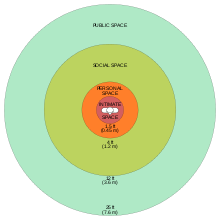Proxemics
I will admit it; I am a space violator. I often find myself choosing to sit in the chair closest to my friends or standing closely to another person in line. I am extremely comfortable being close to others and sometimes I forget that not everyone is as comfortable as I am being close in proximity to one another. To explain why we feel this way, we describe our comfortability as proxemics- the study of space and how we use it, how it makes us feel more or less comfortable, and how we arrange objects and ourselves in relation to space (What is Proxemics?). The difference in the way we feel in different settings is explained by the four zones of proxemics, the intimate zone, personal zone, social zone, and public zone (Moody). The intimate zone goes from 0” inches to 18” in proximity from you to another, the personal zone is up to 48” away from another, the social zone is 48” to 12’, and the public zone is 12’ to 25’. These zones are represented throughout many different scenarios we face daily.
 |
 |
| 201 roomies photo by me |
Sophomore year, I lived in an apartment with two of my best friends. We were attached at the hip and did everything together- cooking, going to the gym, etc, but my favorite activity had to be our movie nights. Because we were all so close, we would often lay in one of our beds to watch the movies together. Although none of us found anything wrong with being so close in proximity to each other, we definitely were invading each other’s intimate zone. Because of our comfortability as friends it was okay. What we did as friends worked easily and never led one of us to feel uncomfortable in such a small space, but if you tried to do this with some of your acquaintances, I doubt you would have the same response. The intimate zone is just that, a zone that creates intimacy between yourself and the people you’re close too that are allowed inside of it. For those who do not like to be to others, it is a zone that creates their bubble and shows others that they need to remain outside of it. The proximity of someone in your intimate zone is based completely off of your own personal preferences and can make the difference of if you’re comfortable in a space or not.
Classrooms
 |
| first day of 15th grade! photo by me |
Because of the smaller student size in the Interior Architecture program at my university, I have all of my classes with the same people. Due to this, I find myself choosing to sit with the same people in all of my classes. Why? Because of the lack of space that is given in the classroom. The person sitting next to me still is intruding on my personal zone, although they do not mean too. At this point in our education, we have all formed relationships with each other and look to each other to be comfortable in the spaces provided. The close proximity of one another in the classroom finds us choosing to sit with those we are already comfortable with and are okay with being in our personal space.
Restaurants
My absolute favorite social interactions of the day are those that include food. From the people I see every day, to the friends I want to catch up with, and even back to others I don’t know very well at all, I always ask if they want to get food sometime as a way of social interaction. That’s why restaurants provide the best social zones. You can choose if you want a booth to insure that there is space between you and your guest, table and chairs to sit closely to friends, or even bar stools to limit the awkward eye contact with your acquaintances. In this zone, you have more freedom to control how you feel depending on the situation and your comfortability with those you are surrounded by.
Church
 |
The largest zone of them all, the public zone, can be used to establish authority or influence amongst others. I think of my church as a public zone. The large space has a designated area for us to sit in, with chairs and aisles are already laid out for use. It also has an area designated for the band and choir, farthest away from the entrance but still in the front with the attention drawn towards them. But the most prominent area of this public space is for our pastor. All of the chairs are faced towards the front and form the aisle leading forwards. The public zone is large enough that one would not feel over crowded, but still is given a direction and a purpose in the area so that the visitor would not feel overwhelmed in the large space.
Resources
Moody, C. (2012, April 09). The Four Zones of Interpersonal Space. Retrieved from https://atworkjax.wordpress.com/2012/04/09/the-four-zones-of-interpersonal-space/
What is Proxemics? (n.d.). Retrieved from https://study.com/academy/lesson/what-is-proxemics-definition-examples.html
I love all of your examples for each different type of zone! I'm happy that we can invade each others personal space because we are so close!
ReplyDelete